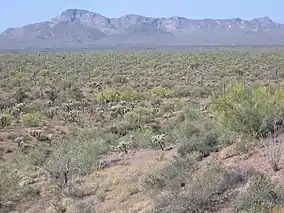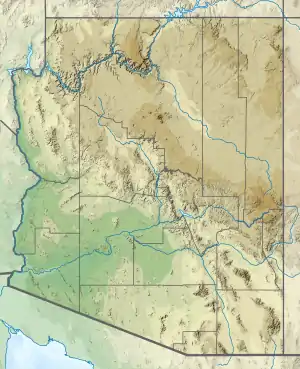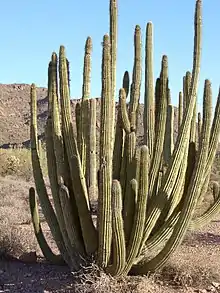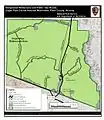Organ Pipe Cactus National Monument
Organ Pipe Cactus National Monument is a U.S. national monument and UNESCO biosphere reserve located in extreme southern Arizona that shares a border with the Mexican state of Sonora. The park is the only place in the United States where the organ pipe cactus grows wild. Along with organ pipe, many other types of cacti and other desert flora native to the Yuma Desert section of the Sonoran Desert region grow in the park. Organ Pipe Cactus National Monument is 517 sq mi (1,340 km2) in size. In 1976 the monument was declared a Biosphere Reserve by UNESCO, and in 1977 95% of Organ Pipe Cactus was declared a wilderness area.
| Organ Pipe Cactus National Monuments | |
|---|---|
IUCN category V (protected landscape/seascape) | |
 | |
  | |
| Location | Pima County, Arizona, USA |
| Nearest city | Ajo, Arizona |
| Coordinates | 31°57′14″N 112°48′03″W |
| Area | 330,688 acres (1,338.25 km2)[1] |
| Created | April 13, 1937 |
| Visitors | 260,375 (in 2018)[2] |
| Governing body | National Park Service |
| Website | Organ Pipe Cactus National Monument |
Land for the Monument was donated by the Arizona state legislature to the federal government during Prohibition knowing that the north–south road would be improved and make contraband alcohol easier to import from Mexico. In 1937 the land was officially opened as a national monument.[3]
At the north entrance of the park is the unincorporated community of Why, Arizona; the town of Lukeville, Arizona at the park's southern border is a border crossing point to Sonoyta, Sonora, Mexico.
Organ Pipe Cactus National Monument is bordered to the northwest by Cabeza Prieta National Wildlife Refuge and to the east by the Tohono O'odham Indian Reservation.[4]
Mexico-United States barrier
The visitor center has been named in honor of Ranger Kris Eggle. On August 9, 2002, he was shot and killed by a drug smuggler during a United States Border Patrol operation. With a continuing, steady flow of immigrants and drug runners from Mexico, the majority of the park was closed in 2003. After being considered the most dangerous national park, the park reopened the backcountry after surveillance towers, vehicle barriers, and pedestrian fences were installed along the border.[5]
The first 30-foot (9.1 m) panels of a new Arizona, US-Mexico border wall were installed in August 2019 on a two-mile (3.2 km) stretch of Organ Pipe Cactus National Monument. It is the first of three projects that will add bollard walls along Southern Arizona's wildlife refuges.[6][7][8] The National Park Service issued a report on September 18, 2019, stating that the barrier wall threatens archaeological artifacts representing 16,000 years of human history.[9] The U.S. Customs and Border Protection agency said that five archaeological sites fall within the area that it wishes to construct.[10]
In February 2020, controlled demolition and other construction work was performed within the Roosevelt Reservation. This strip of land along the border is federally controlled. However, many sites within this region are considered sacred by the Tohono O'odham Nation. Important sites include Monument Hill, which is a ceremonial and historic battle site and burial ground; and Quitobaquito Springs, which is a local water source and the site of an annual salt pilgrimage. For this reason, construction was opposed by many locals, including Representative Raúl Grijalva and Tohono O’odham Nation Chairman Ned Norris, Jr., who testified before Congress on the matter. Customs and Border Protection officials maintained that no human remains or artifacts were discovered in the areas where explosives were used, and that Monument Hill was previously disturbed in 2010 when the existing border fence was installed.[11][12][13][14]
Gallery
 An organ pipe cactus in the Monument
An organ pipe cactus in the Monument Hedgehog cactus and brittlebush in bloom at the National Monument
Hedgehog cactus and brittlebush in bloom at the National Monument The Monument is also home to many saguaro cacti
The Monument is also home to many saguaro cacti The Monument also contains a pair of natural arches
The Monument also contains a pair of natural arches Map of Organ Pipe and its designated wilderness
Map of Organ Pipe and its designated wilderness
See also
- Bates Well Ranch, listed on the National Register of Historic Places within the park
- Dos Lomitas Ranch, also listed on the NRHP
- Growler Valley and Growler Mountains geographic features located within the park
- El Camino del Diablo historic road that traverses a section of the monument
References
- "Listing of acreage as of December 31, 2011". Land Resource Division, National Park Service. Retrieved 2012-05-14.
- "NPS Annual Recreation Visits Report". National Park Service. Retrieved 2019-06-15.
- "Listing of National Park System Areas by State". National Park Service. Retrieved 2011-06-30.
- Brean, Henry (August 15, 2019). "Trump administration delays border wall work in Arizona preserves". Arizona Daily Star. Retrieved August 15, 2019.
- Smith, Dylan; Ingram, Paul (August 25, 2019). "New border wall going up in Arizona's Organ Pipe National Monument". Tucson Sentinel. Tucson, Arizona. Retrieved August 28, 2019.
- Carranza, Rafael (August 23, 2019). "Trump administration begins to replace existing border barriers in Arizona using military funds". The Arizona Republic. Retrieved August 28, 2019 – via AZCentral.
- Prendergast, Curt (September 1, 2019). "Border wall rising near Lukeville". Arizona Daily Star. Retrieved 2019-09-02.
- Chantal Da Silva (Sep 18, 2019). "Donald Trump's border wall could see 16,000 years of history destroyed, National Park Service report warns". Newsweek.
- Devereaux, Ryan (2020-02-06). "Trump Is Blowing Up a National Monument in Arizona to Make Way for the Border Wall". The Intercept. Retrieved 2020-02-07.
- Prendergast, Curt (February 8, 2020). "Crews blasting hill in Organ Pipe monument to make way for border wall". Arizona Daily Star. Retrieved 2020-02-07.
- Prendergast, Kurt (February 27, 2020). "Border Patrol offers view of blasting for wall on Organ Pipe National Monument". Arizona Daily Star. Retrieved March 27, 2020.
- Hsieh, Steven (2020-02-27). "Tohono O'odham Chairman to Congress: Trump's Wall Is Destroying Tribal Sites". Phoenix New Times. Retrieved 2020-07-23.
>Peterson, Jodi (2014-09-17). "After 11 years, Organ Pipe Cactus National Monument reopens". High Country News. Retrieved 2020-11-07.</ref>
[1] }}
External links
| Wikimedia Commons has media related to Organ Pipe Cactus National Monument. |
| Wikivoyage has a travel guide for Organ Pipe Cactus National Monument. |
- Burnett, John (October 11, 2019). "Border Wall Construction In Arizona Bulldozes Cactus Columns". NPR News. Retrieved 2020-11-07.